Mary, the Lord's Servant: Availability
For Sunday December 18, 2005
Fourth Sunday in Advent
Lectionary Readings (Revised Common Lectionary, Year B)
2 Samuel 7:1–11, 16
Luke 1:47–55, Psalm 89:1–4, 19–26
Romans 16:25–27
Luke 1:26–38
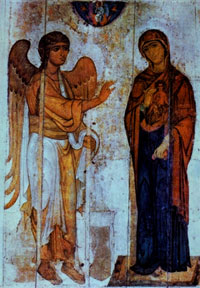 |
The Annunciation, 12th century Russian icon. |
In his Gospel this week the physician Luke tells the story of two births. The angel Gabriel announced both of these births to the parents, but Christians celebrate only one of them, at the Feast of the Annunciation every March 23—precisely nine months before we celebrate the birth of Jesus Christ, for
This was the moment when Before
Turned into After, and the future's
Uninvented timekeepers presented arms.
(U.A. Fanthorpe, BC:AD)
With the attention to detail that you would expect from a physician, the differences between these two birth narratives are striking.
Luke recounts the birth of John the Baptist from the viewpoint of his father. Zechariah was a married man, too old for sex, and his wife was barren. He was a member of the religious establishment in the holy city of Jerusalem, a priest of the professional class. His vision of the angel Gabriel occurred in the inner sanctuary of the temple. When Gabriel foretold the birth of his son John, Zechariah responded in disbelief and consequently was struck silent so that he could not speak.
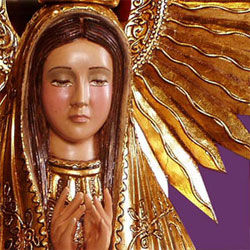 |
Madonna of Loneliness, Oaxaca, Maxico. |
The birth narrative of Jesus is told from the viewpoint of his mother. Mary was a single, teenage girl, too young for sex. Given the strongly patriarchal nature of society in her time and place, Joseph to whom she was betrothed is notable for his invisibility in this story. Mary was a peasant girl from a working class neighborhood of carpenters in Nazareth, a village so insignificant that it is not mentioned in the Old Testament, in the historian Josephus (c. 37–100), or in the Jewish Talmud. "Can anything good come from Nazareth?" (John 1:46). Her encounter took place in an unknown, ordinary house. When the angel Gabriel foretold the birth of her son Jesus, Mary responded in words of faith that have echoed through the centuries: "I am the Lord's servant, may it be to me as you have said." Her bold belief startled her pregnant cousin Elizabeth, who exclaimed "in a loud voice: Blessed are you among women, and blessed is the child you will bear! Blessed is she who has believed that what the Lord has said to her will be accomplished!" (Luke 1:38, 42, 45). Whereas Zechariah was struck silent for his unbelief, Mary praised God in her majestic "Magnificat."
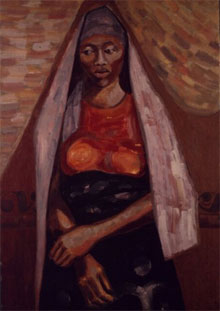 |
African Madonna. |
The son of Mary, Jesus, would be the son of God, God made flesh. Christians in the Eastern Orthodox tradition remind us of a remarkable truth when they therefore honor Mary with the technical term theotokos or "bearer of God" in their special hymn:
Today is the beginning of our salvation,
The revelation of the eternal mystery!
The Son of God becomes the Son of the Virgin
As Gabriel announces the coming of Grace.
Together with him let us cry to the Theotokos:
Rejoice, O Full of Grace,
The Lord is with You!
This term theotokos bestowed upon Mary by church fathers since the third century acknowledges her special role in redemption; she is nothing less than the Mother of God. But when it gained official status at the third ecumenical council of Ephesus in 431, the intent of this term was to emphasize the full divinity of the son more than the privileged status of his mother. Mary did not give birth to a mere man (Christotokos), as the Nestorians taught; she bore a child who was fully divine.
Christians also worship Jesus as the son of Man, and in Gabriel's Annunciation we confess the integrity of his human nature. In that cultural milieu where many men (and a few women) claimed divine status, the startling claim of Christians was not that man became a god but that in Jesus God became a man. Because of His birth to Mary, Christians insist that Jesus is fully and truly human.
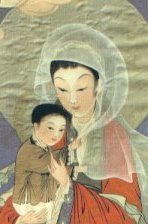 |
Chinese Madonna. |
Our Roman Catholic friends remind us of another "Marian" truth. In some mysterious way the incarnation resulted not only from the work of God the Father but also from the will of the Mother Mary. Numerous church fathers acknowledged Mary's active cooperation in the history of salvation. According to Thomas Aquinas (Summa, III:30), for example, human redemption depended upon the consent of the pregnant teenager Mary. She did not ask to bear the son of God, nor was she compelled to do so. She might have said no, or like Zechariah responded to Gabriel's staggering annunciation in disbelief. But she did not shrink from God's call on her life, and instead enriched all humanity by her willing participation and obedient submission. For that we honor her.
For their part, and to their loss, Protestants have tip-toed around Mary, fearing that such exalted language about her veers too close to making her a co-redeemer of humanity. Anything that elevates Mary to that degree is cause for concern. In more syncretistic and popular forms of Christian folk religion among uneducated people it is not difficult to find such abuses. We have also taken exception to dogmatic formulations about Mary that were made much later and that do not enjoy clear Biblical support, like her freedom from both actual and even original sin (Immaculate Conception, 1854), and the idea that after her death she was taken directly to heaven (Bodily Assumption, 1950). So Protestants rightly press a caution that both Catholics and Orthodox believers themselves acknowledge, that we honor or venerate (duleia) Mary as the Mother of God, but we do not offer her our worship (latreia) which is due to God alone. Genuine veneration of the Mother of God should lead to unambiguous exaltation of the Son of God.
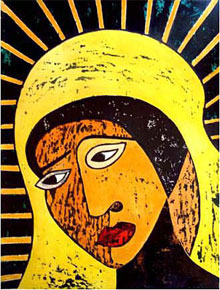 |
Black Madonna. |
Mary played a unique role in the mystery of salvation whereby God humbled himself to be born as the baby of a peasant teenager in order to reconcile the world to Himself. We can only stand in awe of this woman who was faithful to God's call to such an improbable role in redemption. It is no wonder that Mary has become the subject of art and a cultural force throughout the world. John Donne (1572–1631) plumbs the depths of this profound mystery, as only poetry might, in his sonnet Annunciation:
Salvation to all that will is nigh;
That All, which always is all everywhere,
Which cannot sin, and yet all sins must bear,
Which cannot die, yet cannot choose but die,
Lo, faithful virgin, yields Himself to lie
In prison, in thy womb; and though He there
Can take no sin, nor thou give, yet He will wear,
Taken from thence, flesh, which death's force may try.
Ere by the spheres time was created, thou
Wast in His mind, who is thy Son and Brother;
Whom thou conceivst, conceived; yea thou art now
Thy Maker's maker, and thy Father's mother;
Thou hast light in dark, and shutst in little room,
Immensity cloistered in thy dear womb.
An ancient Christian hymn put it even more succinctly: "He whom the entire universe could not contain was contained within your womb, O Theotokos." In other words, Mariology originates from and leads directly to Christology.
For further reflection:
* How have you understood Mary's place in the Gospels?
* What might we gain from the particular emphases of the Orthodox, Catholic and Protestant traditions about Mary?
* What do you take from Donne's sonnet about Mary's relationship to Jesus?
* See Jaroslav Pelikan, Mary Through the Centuries; Her Place in the History of Culture.





